Phonetics Midterm 2
1/144
Earn XP
Description and Tags
IPA
Name | Mastery | Learn | Test | Matching | Spaced |
|---|
No study sessions yet.
145 Terms
What are the four parameters used to describe vowels?
height, backness, lip rounding, tenseness
ipa transcription for the vowel in “heed”
/i/
ipa transcription for the vowel in “food”
/u/
ipa transcription for the vowel in “father”
/ɑ/
ipa transcription for the vowel in “hid”
/ɪ/
ipa transcription for the vowel in “head”
/ɛ/
ipa transcription for the vowel in “had”
/æ/
ipa transcription for the vowel in “good”
/ʊ̈/
/i/
high, front, unrounded, tense vowel
/y/
high, front, rounded, tense vowel
/e/
mid(-high), front, unrounded vowel
/ɛ/
mid(-low), front, unrounded
/œ/
mid(low-), front, rounded
/æ/
raised-low, front, unrounded
/a/
low, front, unrounded
/ɶ/
low, front, rounded
/ɨ/
high, central, unrounded
/ʉ/
high, central, rounded
/ə/
mid(-high), central, unrounded
/ɵ/
mid(-high), central, rounded
/ɜ/
mid(-low), central, unrounded
/ɞ/
mid(-low), central, rounded
/ɯ/
high, back, unrounded
/u/
high, back, rounded
/ɤ/
mid(-high), back, unrounded
/o/
mid(-high), back, rounded
/ʌ/
mid(-low), back, unrounded
/ɔ/
mid(-low), back, rounded
/ɑ/
low, back, unrounded
/ɒ/
low, back, rounded
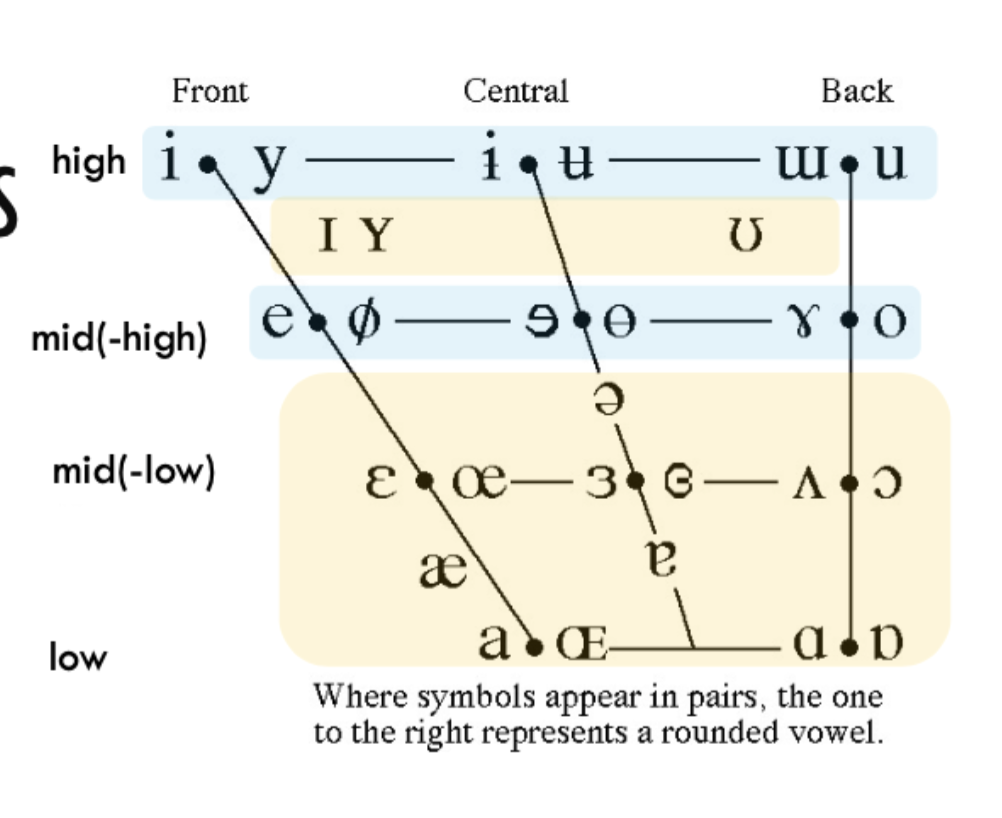
Is what’s highlighted in blue tense or lax?
tense
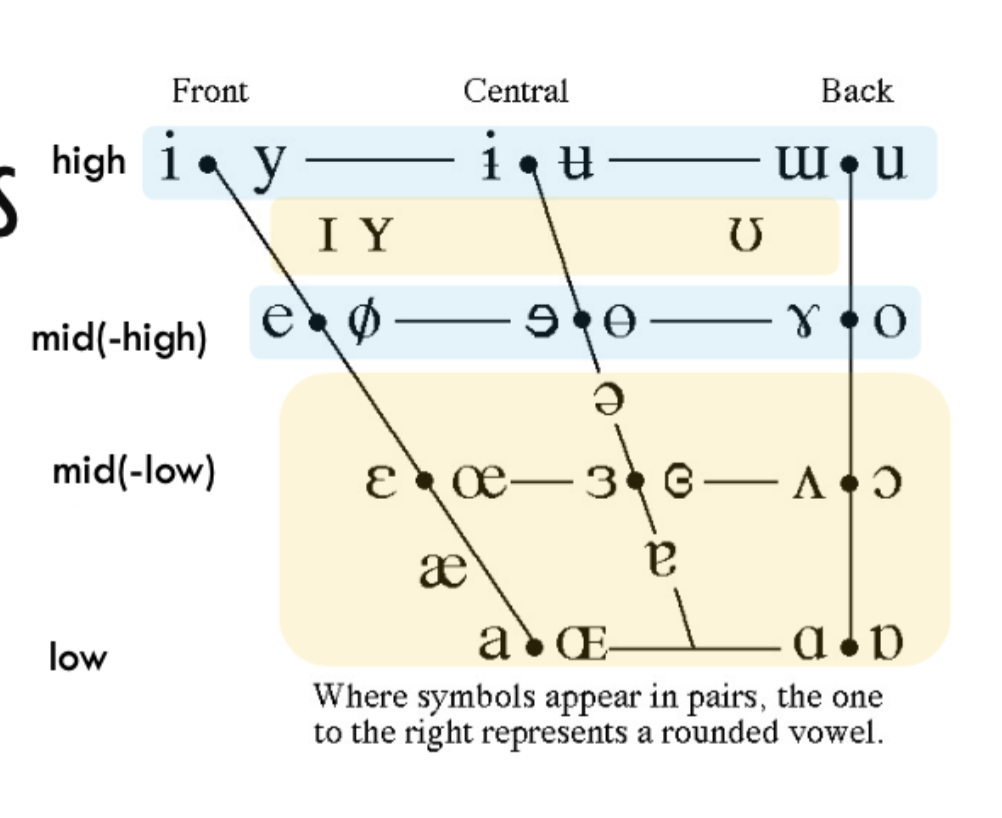
Is what’s highlighted in yellow tense or lax?
lax
What are the cardinal vowels?
series of vowels that serve as standard reference points for the comparison of the vowel qualities of particular languages
What vowels are the most common in the world’s languages (despite there being no symbol for them?)
low central vowels
The vowel /Œ/ is not reported in any natural language.
True
The vowel /ɵ/ is not reported in any natural language.
True
The vowel /ɞ/ is not reported in any natural language.
True
ATR (Advanced tongue root)
vowel distinction characterized by pharyngeal expansion, where tongue is drawn forward by constricting the genioglossus and the larynx is lowered
Where is ATR most often seen in spoken languages?
Africa
RTR stands for
retracted tongue root
Vowels are most often…
oral
oral
nasalized
When can a vowel be nasalized?
when they are next to a nasal consonant
Phonemic nasalization is…
contrastive
Phonetic nasalization is…
non-contrastive
What are rhotic vowels (aka “r-colored vowels” or “rhoticized vowels”)?
vowels that have a modified articulation, more towards /ɹ/
Rhotic vowels are very rare cross-linguistically (<1% of world’s spoken languages, most notably found in English and Mandarin!)
True
How many vowel targets do monopthongs have?
one
How many vowel targets do diphthongs have?
two
For diphthongs, which target is syllabic and which is non-syllabic?
first target (carries the “beat'“ of the syllable)
How many ways (and in what ways) can diphthongs be expressed?
with a non-syllabic diacritic, with a superscript, with a tie bar, and with a semivowel
How many diphthongs are in Mainstream US English?
5
/noʊ haɪweɪ kaʊbɔɪz/
“no highway cowboys” in IPA, to show the 5 diphthongs in mainstream English
Falling diphthongs…
start higher, end lower
Rising diphthongs…
start lower, end higher
vowel length can be contrastive or non-contrastive
True
Vowels before voiced consonants are longer than before voiceless consonants.
True
A language can have both long and short vowels and consonants.
True
Vowels can have tones, or contrastive pitch.
True
Is the rhotic vowel /ɝ/ stressed or unstressed?
stressed, as in bird
Is the rhotic vowel /ɚ/ stressed or unstressed?
unstressed, as in over
When plural or possessive /Z/ is added to some words (like Rose’s), /ɨ/ is inserted = [ɹoʊzɨz]
True
What are the four main IPA parameters for describing consonants?
airstream mechanism, voicing, place of articulation, and manner of articulation
Place of articulation for consonants?
where the consonantal constriction is occurring
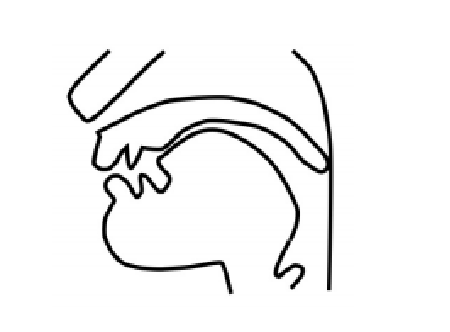
Identify the place of articulation
postalveolar
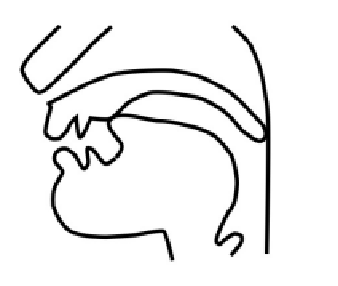
Identify the place of articulation
(post)alveolar
manner of articulation refers to…
the degree of constriction and secondary openings by which sounds are made
Obstruents (aka most of English’s consonants)
have a clear obstruction in the vocal tract
Sonorants (all vowels and some consonants)
have a relatively open vocal tract
Obstruent type: stop/plosive
articulators make a complete closure; all airflow is stopped in the vocal tract
Obstruent type: fricative
articulators are close but there isn’t a complete closure
Obstruent type: affricate
sequence of a stop + fricative release
Affricates are percieved as one sound
True
Sonorant type: nasal (stop)
articulators in full contact, airflow is stopped through oral tract. Velum is lowered and air escapes through nose.
Sonorant type: approximant
articulators shape vocal tract, but don’t impede airflow
What the two types of approximates?
liquids & glides
What is the IPA symbol for a central liquid?
/ɹ/
What is the IPA symbol for a lateral liquid?
/l/
What are the two central glides?
/j/ & /w/
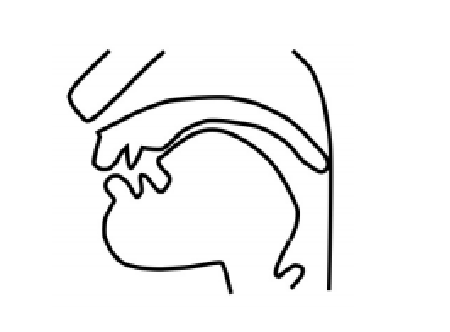
Identify the English phonemes
/ʃ/ or /ʒ/
What is broad transcription?
focuses on aspects of pronounciation that are contrastive, aka “phonemic transcription”
What is narrow transcription?
includes both contrastive and non-contrastive aspects, aka “phonetic transcription”
Voiceless stops are aspirated in word-initial position or beginning a stressed syllable
True
Voiceless stops are unaspirated after /s/
True
Sonorants are devoiced when they follow an initial voiceless stop.
True
Sonorants are produced with creaky voice when they precede a glottal stop
True
Intervocalic /h/ is what at the beginning of a stressed syllable?
voiced
Intervocalic /h/ is what before an stressed syllable?
deleted
Stops are unreleased when they precede another consonant.
True
What happens to /n/ before a consonant?
It assimilates in place of articulation (nasal assimilation)
What happens /m/ before /f/?
It becomes labiodental [ɱ]
What happens to /t,d, n/ before /θ,ð/?
It becomes dental
What happens to /t/ before a nasal? [bʌʔn]
It becomes a glottal stop
alveolars can become postalveolars preceding /j/ [mitʃju]
True
In some varieties of English /t/ and /d/ are tapped in between two vowels, the second of which is stressed (e.g., city becomes [sɪɾi]
True
/I/ is velarized (aka “dark l”) at the end of a syllable [fiɫ]
True
What are the two types of fricatives?
sibilants and non-sibilants
sibilants
louder, higher-pitched noise, where air is directed at an obstacle (teeth) after passing through a constriction
non-sibilants
quieter, lower-pitched noise, with only one source of turbulence, the initial constriction
laminal
formed with tongue blade